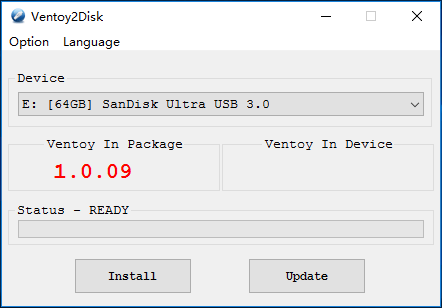

Sudo umount /dev/sdXN Installing the software In the example above you have to write after the command (once per partition) / dev / sdd1 and / dev / sdd2:
Next we have to unmount the partitions with this other command, where we have to replace "sdXN" with our partitions to unmount. If there are partitions, there will be numbers behind it, such as / dev / sdd1 or / dev / sdd2. One possible result would be / dev / sdd. The best thing to make things easier is that there is only one connected, the one we want to use. Once the above command has been entered, it will show us the disks and partitions that are attached to the computer, including the USB. To do this, we connect it to the computer and write the following command: Now we have to identify the name of the USB device. The first is Ventoy2Disk.sh, which will install the tool on the USB, and the second is CreatePersistentImg.sh, which will create a persistent image. If you don't make changes in the future, right now we find three folders and two scripts. We extract the tar.gz file downloaded in the previous step. At the time of writing this article, the available version is ventoy-1.0. and the direct link to its download is this. We download the file for Linux from the download page. Next, we are going to explain how to install Ventoy on a pendrive from Linux, and I personally thank Linux Uprising for the work done and on which this article is based: Possibility of updating the Ventoy installation (which we remember is done on the pendrive) without formatting.īearing in mind that this blog is about Linux (although haters must be reminded that sometimes we write about other topics for general interest reasons), the only thing we are going to say about the Windows version is that it includes graphical interface very intuitive.  Self installation, which will work on supported systems. It works with over 260 images, including popular ones like Debian / Ubuntu, CentOS, RHEL, Windows 7-10, and less popular ones like ALT Linux. Support for "Legacy" and "UEFI Secure Boot". If we need more space, we only have to delete one or more of the added images. The USB can continue to be used as a normal pendrive, which means that we can save documents in free space. Linux users have to use the terminal as we will explain later.
Self installation, which will work on supported systems. It works with over 260 images, including popular ones like Debian / Ubuntu, CentOS, RHEL, Windows 7-10, and less popular ones like ALT Linux. Support for "Legacy" and "UEFI Secure Boot". If we need more space, we only have to delete one or more of the added images. The USB can continue to be used as a normal pendrive, which means that we can save documents in free space. Linux users have to use the terminal as we will explain later. 
Includes graphical interface, but only on Windows.Available for Windows, but also for Linux.When we add more than one, when we start from the USB we will see a menu that will allow us to choose which ISO to start. We can add several ISO to the same pendrive.3 How to create a bootable USB with persistent storage with Ventoy.







 0 kommentar(er)
0 kommentar(er)
